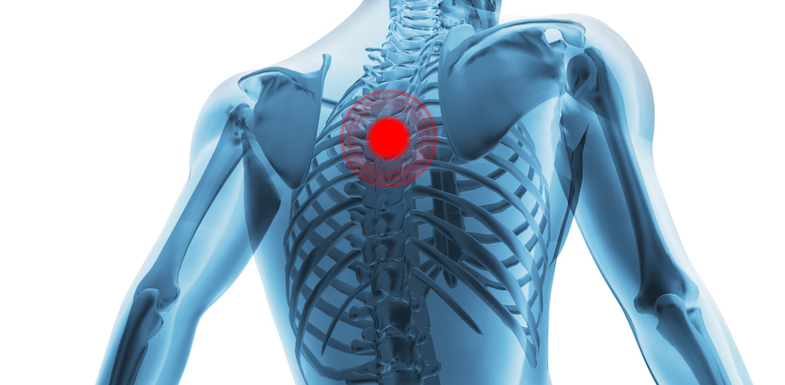
The course of upper back pain—and how to treat it—depends on the underlying cause of the condition. Even in cases where it seems obvious what started the upper back pain, such as an injury from a fall, the specific source of pain within the body can sometimes remain elusive.
Regardless of whether the exact source of upper back pain can be determined, it helps to know the various potential causes in order to better narrow down which treatments may be best.
Common Causes of Upper Back Pain
When the upper back becomes painful, it is most likely due to an injury that has resulted in muscular irritation or joint dysfunction. Some of the more common causes of upper back pain are:
- Poor posture. Living a sedentary lifestyle or routinely sitting for long periods with poor posture can cause structural changes in the back and neck. The muscles can become decondition and weak, and thus not hold the spine in neutral alignment as easily as before. As the head and shoulders hunch forward, more pressure is placed on the spine’s bones, discs, muscles, ligaments, and other soft tissues. If a person leans to one side more often, such as while driving or working at a computer that could also cause an imbalance in the upper back that leads to pain.
- Improper lifting technique. Lifting a heavy object without keeping the spine aligned can put undue stress on the upper back. In particular, lifting or holding a heavy object above the head, especially more toward the left or right as opposed to center, can leave the shoulder and upper back susceptible to injury. Lifting an object that is too heavy can also cause upper back pain.
- Overuse. Putting the upper back through more work than usual, such as by spending a day helping a friend move into a new apartment or painting a ceiling (working above the head), could cause muscle strains, ligament sprains, and inflammation in the upper back.
- Accident or collision. Trauma from a vehicular accident (car or bike crash), a fall from height (down steps or from a ladder), or sports collision (football, hockey, etc.) can cause upper back pain by injuring spinal bones, discs, muscles, ligaments, nerves, and/or other soft tissues.
Sometimes there can be a combination of causes, such as from both overuse and improper lifting technique.
Less Common Causes of Upper Back Pain
Some of the less common causes of upper back pain include:
- Thoracic herniated disc. While herniated discs in the thoracic spine are not uncommon, it is rare for one to cause pain or other symptoms. In general, natural age-related spinal degeneration is much more likely to cause symptoms in the cervical spine and lumbar spine.
- Compression fractures. Most commonly caused by osteoporosis in older adults, a vertebral bone can weaken and not be able to fully support the weight above it. Small fractures develop at the front of the vertebra as it becomes compressed, causing the vertebra to form more of a wedge shape. If the vertebra loses enough height, it can cause postural changes and become painful.
- Arthritis. Various types of arthritis can occur in or spread to the thoracic spine, such osteoarthritis (from natural wear and tear) or rheumatoid arthritis (an autoimmune disease).
- Fibromyalgia. While this rare condition is known for widespread pain and fatigue throughout the body, the upper back is commonly affected.
- Severe spinal deformity. If a spinal deformity progresses enough, it can cause painful muscle spasms and even stress discs and joints. A few examples include Scheuermann’s kyphosis and scoliosis.
Numerous other causes of upper back pain exist, such as from an infection or a tumor pressing on the spinal cord.
Risk Factors for Developing Upper Back Pain
There tends to be an increased risk for back pain as a person ages, but that correlation does not hold up as well in the upper back compared to the neck and lower back. Some research indicates that adolescents—particularly older adolescents—are at higher risk for upper back pain compared to other age groups.
Other risk factors for developing upper back pain include having weakened core and back muscles, female gender, other musculoskeletal pain, and poorer mental health.
If you are suffering from pain, please contact our office at (516) 419-4480 or (718) 215-1888 to arrange an appointment with our Interventional Pain Management Specialist, Dr. Jeffrey Chacko.













